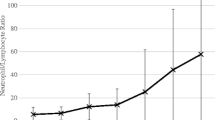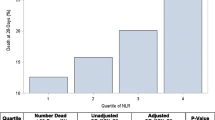Abstract
Purpose
To explore whether monocytes, lymphocytes, and platelets have a predictive value for short-term neutrophil changes in patients with severe neutropenia (SN) induced by chemotherapy.
Methods
Complete blood counts (CBC) were collected from a total of 62 patients with chemotherapy-induced SN from December 2013 to March 2018. CBCs at intervals of 1 day, 2 days, 3 days, 4 days, and 5 days were recorded, and logistic regression analyses were performed to determine whether the monocyte percentage (MP), absolute monocyte count (AMC), lymphocyte percentage (LP), absolute lymphocyte count (ALC), or platelet count (PC) were correlated with short-term neutrophil changes. The areas under the receiver operating characteristic (ROC) curves (AUCs) were calculated for parameters with a P value < 0.05.
Results
The MP was significantly correlated with changes in neutrophils for intervals of 1 to 5 days, while the LP was significantly correlated with changes in neutrophils for intervals of 2 to 5 days. A cutoff value of 6.5% for the MP yielded a sensitivity of 80%, a specificity of 88.6%, and an AUC of 0.908 for predicting an increase in neutrophils on the third day. A cutoff value of 14.75% for the LP yielded a sensitivity of 93.3%, a specificity of 70.3%, and an AUC of 0.812 for predicting an increase in neutrophils on the sixth day.
Conclusions
In chemotherapy-induced neutropenia patients, the MP is the best predictor of short-term neutrophil changes. Close monitoring and proper interpretation of the MP and LP are informative in managing chemotherapy-induced neutropenia.


Similar content being viewed by others
References
Kuderer NM, Dale DC, Crawford J, Cosler LE, Lyman GH (2006) Mortality, morbidity, and cost associated with febrile neutropenia in adult cancer patients. Cancer 106(10):2258–2266. https://doi.org/10.1002/cncr.21847
Chirivella I, Bermejo B, Insa A, Perez-Fidalgo A, Magro A, Rosello S, Garcia-Garre E, Martin P, Bosch A, Lluch A (2009) Optimal delivery of anthracycline-based chemotherapy in the adjuvant setting improves outcome of breast cancer patients. Breast Cancer Res Treat 114(3):479–484. https://doi.org/10.1007/s10549-008-0018-1
Radosavljevic D, Golubicic I, Gavrilovic D, Kezic I, Jelic S (2009) Do the time to chemotherapy response and the dose intensity have an impact on patient outcome in advanced non-small cell lung cancer? J BUON 14(2):203–209
Bosly A, Bron D, Van Hoof A, De Bock R, Berneman Z, Ferrant A, Kaufman L, Dauwe M, Verhoef G (2008) Achievement of optimal average relative dose intensity and correlation with survival in diffuse large B-cell lymphoma patients treated with CHOP. Ann Hematol 87(4):277–283. https://doi.org/10.1007/s00277-007-0399-y
Jenkins P, Freeman S (2009) Pretreatment haematological laboratory values predict for excessive myelosuppression in patients receiving adjuvant FEC chemotherapy for breast cancer. Annals of oncology : official journal of the European Society for. Med Oncol 20(1):34–40. https://doi.org/10.1093/annonc/mdn560
Chen K, Zhang X, Deng H, Zhu L, Su F, Jia W, Deng X (2014) Clinical predictive models for chemotherapy-induced febrile neutropenia in breast cancer patients: a validation study. PLoS One 9(6):e96413. https://doi.org/10.1371/journal.pone.0096413
Oguz A, Karadeniz C, Ckitak EC, Cil V (2006) Which one is a risk factor for chemotherapy-induced febrile neutropenia in childhood solid tumors: early lymphopenia or monocytopenia? Pediatr Hematol Oncol 23(2):143–151. https://doi.org/10.1080/08880010500457673
Ray-Coquard I, Borg C, Bachelot T, Sebban C, Philip I, Clapisson G, Le Cesne A, Biron P, Chauvin F, Blay JY, group Es (2003) Baseline and early lymphopenia predict for the risk of febrile neutropenia after chemotherapy. Br J Cancer 88(2):181–186. https://doi.org/10.1038/sj.bjc.6600724
Choi CW, Sung HJ, Park KH, Yoon SY, Kim SJ, Oh SC, Seo JH, Kim BS, Shin SW, Kim YH, Kim JS (2003) Early lymphopenia as a risk factor for chemotherapy-induced febrile neutropenia. Am J Hematol 73(4):263–266. https://doi.org/10.1002/ajh.10363
Shikata H, Yakushijin Y, Yamanouchi J, Azuma T, Yasukawa M (2014) Analysis of chemotherapy-induced neutropenia and optimal timing for prophylactic use of G-CSF in B-cell non-Hodgkin lymphoma patients treated with R-CHOP. Int J Clin Oncol 19(1):178–185. https://doi.org/10.1007/s10147-013-0523-z
Bozcuk H, Yildiz M, Artac M, Kocer M, Kaya C, Ulukal E, Ay S, Kilic MP, Simsek EH, Kilickaya P, Ucar S, Coskun HS, Savas B (2015) A prospectively validated nomogram for predicting the risk of chemotherapy-induced febrile neutropenia: a multicenter study. Support Care Cancer 23(6):1759–1767. https://doi.org/10.1007/s00520-014-2531-6
Chen W, Zheng R, Baade PD, Zhang S, Zeng H, Bray F, Jemal A, Yu XQ, He J (2016) Cancer statistics in China, 2015. CA Cancer J Clin 66(2):115–132. https://doi.org/10.3322/caac.21338
National Comprehensive Cancer Network (2017) NCCN clinical practice guidelines in oncology (NCCN Guidelines). Myeloid growth factors. Version 1. Available at: www.nccn.org. Accessed 7 July 2017
Dulisse B, Li X, Gayle JA, Barron RL, Ernst FR, Rothman KJ, Legg JC, Kaye JA (2013) A retrospective study of the clinical and economic burden during hospitalizations among cancer patients with febrile neutropenia. J Med Econ 16(6):720–735. https://doi.org/10.3111/13696998.2013.782034
Weycker D, Li X, Tzivelekis S, Atwood M, Garcia J, Li Y, Reiner M, Lyman GH (2017) Burden of chemotherapy-induced febrile neutropenia hospitalizations in US clinical practice, by use and patterns of prophylaxis with colony-stimulating factor. Support Care Cancer 25(2):439–447. https://doi.org/10.1007/s00520-016-3421-x
Jenkins P, Scaife J, Freeman S (2012) Validation of a predictive model that identifies patients at high risk of developing febrile neutropaenia following chemotherapy for breast cancer. Ann Oncol 23(7):1766–1771. https://doi.org/10.1093/annonc/mdr493
Klastersky J, Paesmans M, Rubenstein EB, Boyer M, Elting L, Feld R, Gallagher J, Herrstedt J, Rapoport B, Rolston K, Talcott J (2000) The Multinational Association for Supportive Care in Cancer risk index: a multinational scoring system for identifying low-risk febrile neutropenic cancer patients. J Clin Oncol 18(16):3038–3051. https://doi.org/10.1200/JCO.2000.18.16.3038
Klastersky J, Paesmans M (2013) The Multinational Association for Supportive Care in Cancer (MASCC) risk index score: 10 years of use for identifying low-risk febrile neutropenic cancer patients. Support Care Cancer 21(5):1487–1495. https://doi.org/10.1007/s00520-013-1758-y
de Naurois J, Novitzky-Basso I, Gill MJ, Marti FM, Cullen MH, Roila F, Group EGW (2010) Management of febrile neutropenia: ESMO clinical practice guidelines. Ann Oncol 21(Suppl 5):v252–v256. https://doi.org/10.1093/annonc/mdq196
Hughes WT, Armstrong D, Bodey GP, Bow EJ, Brown AE, Calandra T, Feld R, Pizzo PA, Rolston KV, Shenep JL, Young LS (2002) 2002 guidelines for the use of antimicrobial agents in neutropenic patients with cancer. Clin Infect Dis 34(6):730–751. https://doi.org/10.1086/339215
Freifeld AG, Bow EJ, Sepkowitz KA, Boeckh MJ, Ito JI, Mullen CA, Raad II, Rolston KV, Young JA, Wingard JR, Infectious Diseases Society of A (2011) Clinical practice guideline for the use of antimicrobial agents in neutropenic patients with cancer: 2010 update by the Infectious Diseases Society of America. Clin Infect Dis 52(4):e56–e93. https://doi.org/10.1093/cid/cir073
Lalami Y, Paesmans M, Muanza F, Barette M, Plehiers B, Dubreucq L, Georgala A, Klastersky J (2006) Can we predict the duration of chemotherapy-induced neutropenia in febrile neutropenic patients, focusing on regimen-specific risk factors? A retrospective analysis. Ann Oncol 17(3):507–514. https://doi.org/10.1093/annonc/mdj092
San Matias S, Clemente M, Giner-Bosch V, Giner V (2011) Predicting the duration of chemotherapy-induced neutropenia: new scores and validation. Ann Oncol 22(1):181–187. https://doi.org/10.1093/annonc/mdq332
Lyman GH, Abella E, Pettengell R (2014) Risk factors for febrile neutropenia among patients with cancer receiving chemotherapy: a systematic review. Crit Rev Oncol Hematol 90(3):190–199. https://doi.org/10.1016/j.critrevonc.2013.12.006
Carmona-Bayonas A, Jimenez-Fonseca P, Virizuela Echaburu J, Antonio M, Font C, Biosca M, Ramchandani A, Martinez J, Hernando Cubero J, Espinosa J, Martinez de Castro E, Ghanem I, Beato C, Blasco A, Garrido M, Bonilla Y, Mondejar R, Arcusa Lanza MA, Aragon Manrique I, Manzano A, Sevillano E, Castanon E, Cardona M, Gallardo Martin E, Perez Armillas Q, Sanchez Lasheras F, Ayala de la Pena F (2015) Prediction of serious complications in patients with seemingly stable febrile neutropenia: validation of the clinical index of stable febrile neutropenia in a prospective cohort of patients from the FINITE study. J Clin Oncol 33(5):465–471. https://doi.org/10.1200/JCO.2014.57.2347
Author information
Authors and Affiliations
Corresponding author
Ethics declarations
Conflict of interest
The authors declare that they have no conflicts of interest.
Additional information
Publisher’s note
Springer Nature remains neutral with regard to jurisdictional claims in published maps and institutional affiliations.
Rights and permissions
About this article
Cite this article
Zheng, B., Huang, Z., Huang, Y. et al. Predictive value of monocytes and lymphocytes for short-term neutrophil changes in chemotherapy-induced severe neutropenia in solid tumors. Support Care Cancer 28, 1289–1294 (2020). https://doi.org/10.1007/s00520-019-04946-3
Received:
Accepted:
Published:
Issue Date:
DOI: https://doi.org/10.1007/s00520-019-04946-3




